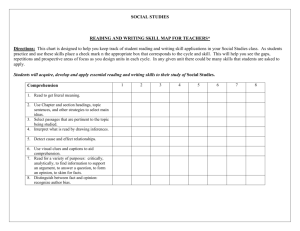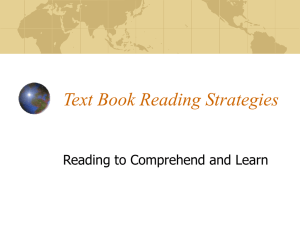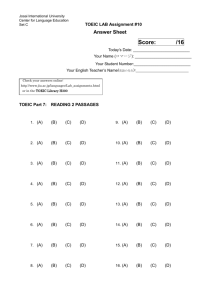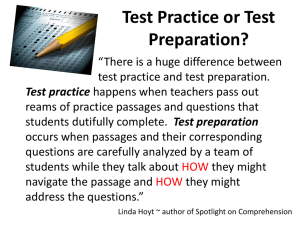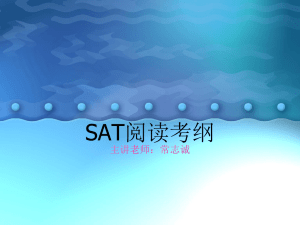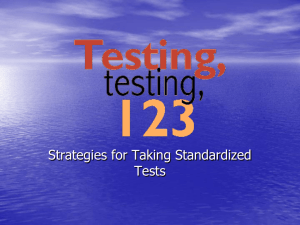INTRODUCTION TO METHOD FOR TEACHING TOEIC TESTS
advertisement
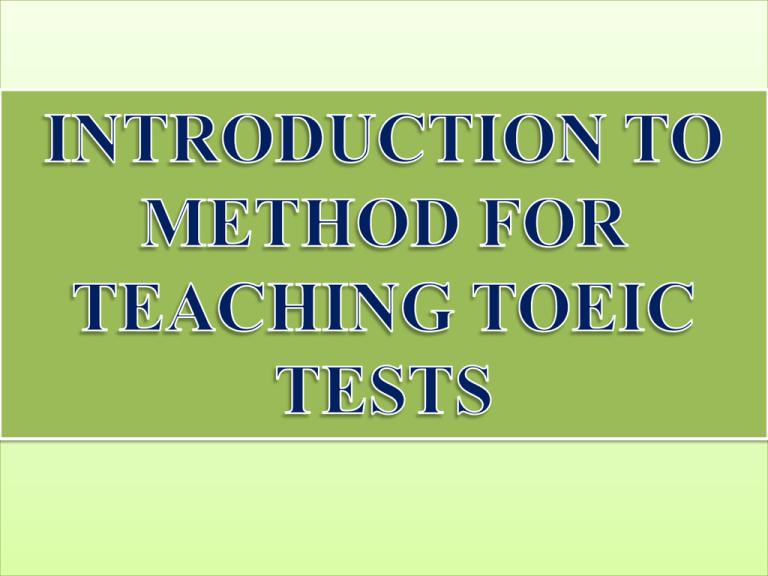
I. Purpose of The Test II. Types of Questions III. General Test-taking Strategy I. THE PURPOSE OF THE TEST The Test of English for International Communication (TOEIC) measures the ability of non-native Englishspeaking examinees to use English in everyday workplace activities. Therefore, have students focus on vocabulary related to the real-life work settings: •Corporate development •Entertainment •Finance & Budgeting •General Business •Housing / Corporate Property •Office •Personnel •Purchasing •Health •Travel II. Types of Questions for Reading Comprehension Make them be aware of the format of this part: ‘Reading Comprehension’ Incomplete sentences Text Completion 40 questions 12 questions Reading Reading Comprehension Comprehension (Single passages) (double passages) 28 questions 20 questions Maximum scores for reading comprehension = 495 scores Total 100 questions/ 75 minutes III. General Test-taking Strategy Tell them how to deal with each part in the Reading Comprehension In part 5, in order to deal with the incomplete sentences * Ask them to see if the question deals with grammar or vocabulary. * If grammar, tell them to identify functions of the words or phrases related to other factors in the sentence. If it’s vocabulary, * identify parts of speech. * figure out the contextual meaning of the target words or phrases. * pay attention to prefixes or suffixes For part 6 Text completion, teachers ask students to • read the instruction to make sure what they are asked to do. • scan the whole text to see the text types • look at the language (formal – informal) used in order to find out whether it is a letter an announcement a notice a memo an email It’s easier for them to finish the task. HOW TO WORK ON PART 7? They are reading documents in forms of single & double passages. FOR SINGLE PASSAGES First skim the questions and put in mind the key words – who/where/what …or nouns, adjectives, or phrasal verbs … Then, read the text and be prudent with the text type in order to facilitate your reading. Next, locate the key information in the text and check if it really matches with the answer. After that, be awake with the format of the questions – multiple choices (Please remember that only one choice is correct while the other three are distracters.) • Delete the two most unreasonable or illogical choices • Compare the two most likely options By following this techniques, you’ll reduce the risk of choosing the wrong answer out of confusion or psychological pressure NOW answer the question. FOR DOUBLE PASSAGES The same processes happen. BUT have your students read both passages to see the relationship between them. information needed is spread over the two passages. TOEIC READING TECHNIQUES TOEIC READING TIPS The TOEIC Reading Tips lesson is designed to guide the student through some methods of improving their ability to answer questions without understanding every word of a reading passage as well as their test-taking speed. •Read the questions and answers first. Think about what kind of answer the question needs. •Skim means read the keywords of the reading passage. •Answer the questions to which you know the answers. •Scan the reading passage for answers to questions to which you don’t know the answers. How to Skim Reading When you read, you don’t need to read and understand every word. In fact, to answer questions in the TOEIC reading sections, you often do not have to understand all the words. You just have to find the answers. You don’t have to understand the answer. Skim reading will help you read quickly so that you have more time to finish the test or to go back and check your answers. When you skim, you only read the key words in the sentence. You skip over the small words which are not necessary in understanding the content of the lesson. Skim reading will help you read quickly so that you have more time to finish the test or to go back and check your answers. When you skim, you only read the key words in the sentence. You skip over the small words which are not necessary in understanding the content of the lesson. The key words are usually: •Nouns (the subject of the sentence and direct objects especially) •Main Verbs •Adverbs (especially adverbs of frequency or time usually, now, etc.) •Numbers •Wh. Words The non-key words are usually: •Conjunctions (and, but, or) •Idioms (needless, regardless of, in terms of) •Descriptive adverbs (fortunately, unfortunately) •Prepositions (in, on, out) If you read only the key words, you should be able to answer the questions and read much more quickly and you will have the same chance of answering the questions correctly as if you had read every word. • From Ms. Ngo Thi Bach Loan – M.A in TESOL
